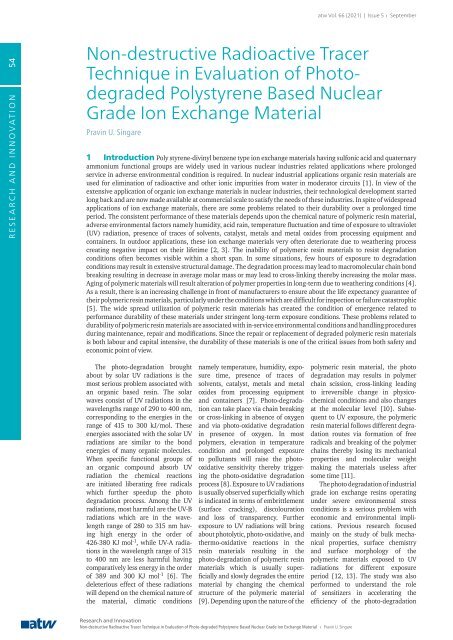atw - International Journal for Nuclear Power | 05.2021
Description Ever since its first issue in 1956, the atw – International Journal for Nuclear Power has been a publisher of specialist articles, background reports, interviews and news about developments and trends from all important sectors of nuclear energy, nuclear technology and the energy industry. Internationally current and competent, the professional journal atw is a valuable source of information. www.nucmag.com
Description
Ever since its first issue in 1956, the atw – International Journal for Nuclear Power has been a publisher of specialist articles, background reports, interviews and news about developments and trends from all important sectors of nuclear energy, nuclear technology and the energy industry. Internationally current and competent, the professional journal atw is a valuable source of information.
www.nucmag.com
You also want an ePaper? Increase the reach of your titles
YUMPU automatically turns print PDFs into web optimized ePapers that Google loves.
<strong>atw</strong> Vol. 66 (2021) | Issue 5 ı September<br />
RESEARCH AND INNOVATION 54<br />
Non-destructive Radioactive Tracer<br />
Technique in Evaluation of Photodegraded<br />
Polystyrene Based <strong>Nuclear</strong><br />
Grade Ion Exchange Material<br />
Pravin U. Singare<br />
1 Introduction Poly styrene-divinyl benzene type ion exchange materials having sulfonic acid and quaternary<br />
ammonium functional groups are widely used in various nuclear industries related applications where prolonged<br />
service in adverse environmental condition is required. In nuclear industrial applications organic resin materials are<br />
used <strong>for</strong> elimination of radioactive and other ionic impurities from water in moderator circuits [1]. In view of the<br />
extensive application of organic ion exchange materials in nuclear industries, their technological development started<br />
long back and are now made available at commercial scale to satisfy the needs of these industries. In spite of widespread<br />
applications of ion exchange materials, there are some problems related to their durability over a prolonged time<br />
period. The consistent per<strong>for</strong>mance of these materials depends upon the chemical nature of polymeric resin material,<br />
adverse environmental factors namely humidity, acid rain, temperature fluctuation and time of exposure to ultraviolet<br />
(UV) radiation, presence of traces of solvents, catalyst, metals and metal oxides from processing equipment and<br />
containers. In outdoor applications, these ion exchange materials very often deteriorate due to weathering process<br />
creating negative impact on their lifetime [2, 3]. The inability of polymeric resin materials to resist degradation<br />
conditions often becomes visible within a short span. In some situations, few hours of exposure to degradation<br />
conditions may result in extensive structural damage. The degradation process may lead to macromolecular chain bond<br />
breaking resulting in decrease in average molar mass or may lead to cross-linking thereby increasing the molar mass.<br />
Aging of polymeric materials will result alteration of polymer properties in long-term due to weathering conditions [4].<br />
As a result, there is an increasing challenge in front of manufacturers to ensure about the life expectancy guarantee of<br />
their polymeric resin materials, particularly under the conditions which are difficult <strong>for</strong> inspection or failure catastrophic<br />
[5]. The wide spread utilization of polymeric resin materials has created the condition of emergence related to<br />
per<strong>for</strong>mance durability of these materials under stringent long-term exposure conditions. These problems related to<br />
durability of polymeric resin materials are associated with in-service environmental conditions and handling procedures<br />
during maintenance, repair and modifications. Since the repair or replacement of degraded polymeric resin materials<br />
is both labour and capital intensive, the durability of these materials is one of the critical issues from both safety and<br />
economic point of view.<br />
The photo-degradation brought<br />
about by solar UV radiations is the<br />
most serious problem associated with<br />
an organic based resin. The solar<br />
waves consist of UV radiations in the<br />
wavelengths range of 290 to 400 nm,<br />
corresponding to the energies in the<br />
range of 415 to 300 kJ/mol. These<br />
energies associated with the solar UV<br />
radiations are similar to the bond<br />
energies of many organic molecules.<br />
When specific functional groups of<br />
an organic compound absorb UV<br />
radiation the chemical reactions<br />
are initiated liberating free radicals<br />
which further speedup the photo<br />
degradation process. Among the UV<br />
radiations, most harmful are the UV-B<br />
radiations which are in the wavelength<br />
range of 280 to 315 nm having<br />
high energy in the order of<br />
426-380 KJ mol -1 , while UV-A radiations<br />
in the wavelength range of 315<br />
to 400 nm are less harmful having<br />
comparatively less energy in the order<br />
of 389 and 300 KJ mol -1 [6]. The<br />
deleterious effect of these radiations<br />
will depend on the chemical nature of<br />
the material, climatic conditions<br />
namely temperature, humidity, exposure<br />
time, presence of traces of<br />
solvents, catalyst, metals and metal<br />
oxides from processing equipment<br />
and containers [7]. Photo-degradation<br />
can take place via chain breaking<br />
or cross-linking in absence of oxygen<br />
and via photo-oxidative degradation<br />
in presence of oxygen. In most<br />
polymers, elevation in temperature<br />
condition and prolonged exposure<br />
to pollutants will raise the photooxidative<br />
sensitivity thereby triggering<br />
the photo-oxidative degradation<br />
process [8]. Exposure to UV radiations<br />
is usually observed superficially which<br />
is indicated in terms of embrittlement<br />
(surface cracking), discolouration<br />
and loss of transparency. Further<br />
exposure to UV radiations will bring<br />
about photolytic, photo-oxidative, and<br />
thermo-oxidative reactions in the<br />
resin materials resulting in the<br />
photo-degradation of polymeric resin<br />
materials which is usually superficially<br />
and slowly degrades the entire<br />
material by changing the chemical<br />
structure of the polymeric material<br />
[9]. Depending upon the nature of the<br />
polymeric resin material, the photo<br />
degradation may results in polymer<br />
chain scission, cross-linking leading<br />
to irreversible change in physicochemical<br />
conditions and also changes<br />
at the molecular level [10]. Subsequent<br />
to UV exposure, the polymeric<br />
resin material follows different degradation<br />
routes via <strong>for</strong>mation of free<br />
radicals and breaking of the polymer<br />
chains thereby losing its mechanical<br />
properties and molecular weight<br />
making the materials useless after<br />
some time [11].<br />
The photo degradation of industrial<br />
grade ion exchange resins operating<br />
under severe environ mental stress<br />
conditions is a serious problem with<br />
economic and environmental implications.<br />
Previous research focused<br />
mainly on the study of bulk mechanical<br />
properties, surface chemistry<br />
and surface morphology of the<br />
polymeric materials exposed to UV<br />
radiations <strong>for</strong> different exposure<br />
period [12, 13]. The study was also<br />
per<strong>for</strong>med to understand the role<br />
of sensitizers in accelerating the<br />
efficiency of the photo-degradation<br />
Research and Innovation<br />
Non-destructive Radioactive Tracer Technique in Evaluation of Photo- degraded Polystyrene Based <strong>Nuclear</strong> Grade Ion Exchange Material ı Pravin U. Singare

















